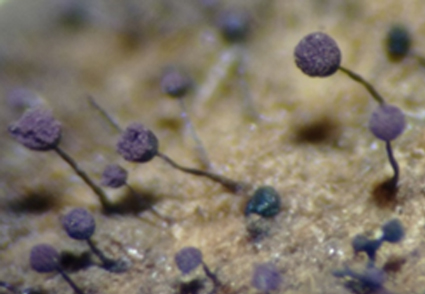Abstract
Samples were collected in Adana province during 2019–2021 and myxomycetes were cultured using the moist chamber technique. The samples consisted of rotten or live tree bark, leaves, rashes, vegetable, and animal material, which were considered likely to contain myxomycete spores. In adddition, natural myxomycete samples were collected at nine different stations. These ‘natural samples’ were immediately dried and potential spore-bearing material was kept in a warm and humid environment with the moist chamber technique. In total, 56 myxomycetes (205 samples; 148 by moist chamber technique and 57 ‘natural samples’) were obtained representing six orders, 12 families, 24 genera and 56 species. Eight species were collected only in natural samples, 35 species were obtained only by moist chamber technique in the laboratory, and 13 species were obtained by both methods. Two myxomycetes as new records (Licea rugosa and Physarum nivale) and one new locality (Cribraria lepida) were identified in Turkey
References
Baba, H. (2021) Five new Myxomycetes (Myxogastria) records from Turkey. Phytotaxa 507 (2): 131–143. https://doi.org/10.11646/phytotaxa.507.2.1
Baba, H., Zumre, M. & Gelen, M. (2016) An investigation on North Adana (Turkey) Myxomycetes. Chiang Mai Journal of Science 43 (1): 54–67.
Baba, H., Cennet, E. & Sevindik, M. (2019) Investigation of Myxomycetes (Myxomycota) in K?r?khan (Hatay Province). Communications Faculty of Sciences University of Ankara Series C 29 (2): 160–169.
Baba, H., Er, A. & Sevindik, M. (2020) Myxomycetes diversity of Belen Region of Hatay Province (Turkey). Kastamonu University Journal of Forestry Faculty 20 (2): 86–96. http://dx.doi.org/10.17475/kastorman.801808
Baba, H., Gündo?du, F. & Sevindik, M. (2021) Myxomycetes biodiversity in Gaziantep Province (Turkey) with four new records. Phytotaxa 478 (1): 105–118. https://doi.org/10.11646/phytotaxa.478.1.7
De Basanta, W.D. & Lado, C. (2005) A taxonomic evaluation of the stipitate Licea species. Fungal Diversity 20: 261–314.
Ejale, A.U. & Gill, L.S. (1991) Identification of Myxomycetes (Order Liceales) from Bendel state Nigeria II. Korean Journal of Mycology 19 (4): 250–252.
Ergül, C.C., Akgul, H. & Oran, R.B. (2016) New records of Mycetozoa taxa from Turkey. Oxidation Communications 39 (2): 1615–1623.
Estrada-Torres, A., Wrigley de Basanta, D., Conde, E. & Lado, C. (2009) Myxomycetes associated with dryland ecosystems of the Tehuacán-Cuicatlán Valley Biosphere Reserve, Mexico. Fungal Diversity 36: 17–56.
Farr, M.L. (1976) Flora Neotropica. Monograph No. 16. New York Botanical Garden Press.
Farr, M.L. (1981) True Slime Molds. Wm. C. Brown Comp., Dubuque, Iowa.
Gilbert, H.C. & Martin, G.W. (1933) Myxomycetes found on the bark of living trees. University of Iowa, Iowa Natural History 15 (3): 3–5.
Ing, B. (1994) The phytosociology of myxomycetes. New Phytologist 126: 175–201. https://doi.org/10.1111/j.1469-8137.1994.tb03937.x
Ing, B. (1999) The Myxomycetes of Britain and Ireland. The Richmond Publishing Co., Slough, England.
Kuhnt, A. (2014) Bemerkenswerte, Schleimpilze (Amoebozoa, Myxomycetes) aus Deutschland: Neu- und Wiederfunde seltener Arten. Berichte der Bayerischen Botanischen Gesellschaft 84: 39–64.
Lado, C. (2005–2021) An on line nomenclatural information system of Eumycetozoa. Real Jardín Botánico, CSIC. Madrid, Spain. Available from: http://www.nomen.eumycetozoa.com (Last updated 13 April 2021)
Lado, C. & Pando, F. (1997) Flora Mycologica Iberica, Vol. 2. CSIC, Madrid, Spain. 323 pp.
Martin, G.W. & Alexopoulos, C.J. (1969) The Myxomycetes. University of Iowa Press, Iowa City, 560 pp.
Martin, G.W., Alexopoulos, C.J. & Farr, M.L. (1983) The Genera of Myxomycetes. University of Iowa Press, Iowa City, 438 pp.
Neubert, H., Nowotny, W. & Baumann, K. (1993) Die Myxomyceten (Band I). Karlheinz Baumann Verlag Gomaringen.
Neubert, H., Nowotny, W. & Baumann, K. (1995) Die Myxomyceten (Band II). Karlheinz Baumann Verlag, Gomaringen.
Neubert, H., Nowotny, W., Baumann, K. & Marx, H. (2000) Die Myxomyceten (Band III). Karlheinz Baumann Verlag, Gomaringen.
Novozhilov, Y.K., Schnittler, M., Erastova, D.A., Okun, M.V., Schepin, O.N. & Heinrich, E. (2013) Diversity of nivicolous myxomycetes of the Teberda State Biosphere Reserve (Northwestern Caucasus, Russia). Fungal Diversity 59: 109–130. https://doi.org/10.1007/s13225-012-0199-0
Ocak, ?. (2015) Seasonal distribution of field-collected myxomycete in the Köro?lubeli forest, Afyonkarahisar, Turkey. Ekoloji 24: 48–56. https://doi.org/10.5053/ekoloji.2015.18
Poulain, M., Meyer, M. & Bozonnet, J. (2011) Les Myxomycètes. Fédération Mycologique et Botanique Dauphiné-Savoie. Sevrier Pl 215: 406.
Ramírez-Ortega, J.M., Estrada-Torres, A. & De Luna, E. (2017) A comparative SEM study of morphological characters in Cribraria. Mycotaxon 132: 391–419. https://dx.doi.org/10.5248/132.391
Stephenson, S.L. (2014) A comparative species listing of myxomycetes from tropical (Philippines) and temperate (United States) forests. Mycosphere 5 (2): 299–311. https://dx.doi.org/10.5943/mycosphere/5/2/4
Stephenson, S.L. & Stempen, H. (1994) Myxomycetes: A Handbook of Slime Molds. Timber Press, Portland, Oregan, USA.
Stephenson, S.L., Kalyanasundaram, I. & Lakhanpal, T.N. (1993) A comparative biogeographical study of myxomycetes in the mid-Appalachians of eastern North America and two regions of India. Journal of Biogeography 20: 645–657. https://doi.org/10.2307/2845520
Stephenson, S.L., Novozhilov, Y.K. & Schnittler, M. (2000) Distribution and ecology of myxomycetes in high latitude regions of the northern hemisphere. Journal of Biogeography 27: 741–754. https://doi.org/10.1046/j.1365-2699.2000.00442.x
Thind, K.S. (1977) The Myxomycetes of India. I.C.A.R., New Delhi, 702 pp.
Vlasenko, A.V., Novozhilov, Y.K., Shchepin, O.N. & Vlasenko, V.A. (2016) Hydrochory as certain mode of distribution of myxomycetes along floodlands in South of Western Siberia. Mikologiya I Fitopatologiya 50 (1): 14–23.


